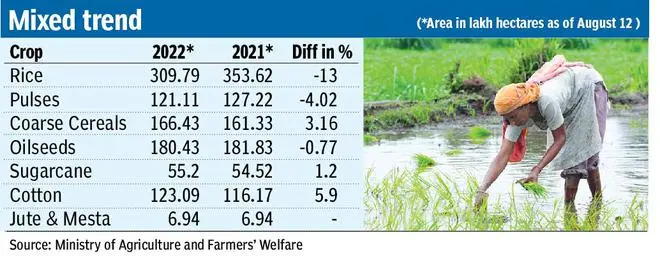Though India has received 8 per cent excess rainfall during the South-West monsoon, its uneven coverage in Eastern and Central parts—resulting in deficiency and heavy excess downpour—has resulted in the sowing of key kharif crops such as paddy, pulses and oilseeds being affected.
According to the Ministry of Agriculture and Farmers Welfare, the total area covered under kharif crops till now is 963.99 lakh hectares (lh) against 1,001.61 lh during the same period a year ago.
Among the paddy-growing areas, key States such as West Bengal (-21%), Bihar (-38%), Jharkhand (-41%), Uttar Pradesh (-44%) and Uttarkhand (-10%) are deficient in rains.
Need to resow
On the other hand, excess rains in Telangana (78%), Karnataka (38%), Tamil Nadu (91%) and Andhra Pradesh (23%) have affected the sowing of paddy, pulses, cotton and coarse cereals. Some of the fields have got inundated that farmers need to resow their crops.
The monsoon’s behaviour is reflected in the storage position in the 143 major reservoirs across the country and how various States have been impacted.

According to the Central Water Commission, the storage is 49 per cent below the normal level (the average level of the past 10 years) in Jharkhand, 47 per cent in West Bengal, 51 per cent in Bihar, 30 per cent in Uttar Pradesh, six per cent in Chhattisgarh and 34 per cent in Odisha, where rainfall has been reported normal only now.
As a consequence, the coverage of paddy is lower in Jharkhand (3.86 lh vs 15.25 lh), Telangana (9.68 lh vs 13.07 lh), Uttar Pradesh (56.03 vs 59.04 lh), West Bengal (24.3 lh vs 35.53 lh), Andhra Pradesh (8.28 lh vs 11.12 lh), Bihar (26.27 lh vs 30.27 lh), Chhattisgarh (32.25 lh vs 33.68), Karnataka (4.23 lh vs 4.38 lh) and Madhya Pradesh (25.48 lh vs 29.94 lh).
13% jump in bajra area
In the case of Madhya Pradesh, Karnataka, Telangana and Andhra Pradesh, excess rainfall has resulted in the area being lower, while deficient rain is the reason for slack coverage in other States.
A 13.64 per cent jump in the acreage of bajra has helped coarse cereals sowing this year with the coverage in Rajasthan, in particular, increasing by over 8 lh. Uttar Pradesh has reported a marginal rise.
The area under jowar is down by 2.64 per cent at 12.91 lh, mainly in view of the acreage declining in Maharashtra and Uttar Pradesh. The sowing of maize has finally caught up with the reality of record-high prices currently in the market with sowing increasing in Maharashtra, Karnataka and Rajasthan.
Soya heads for record high
Among pulses, tur (arhar or pigeon pea) has shown a sharp drop of 11.67 per cent with the acreage slipping (42 lh vs 47.55 lh), while the area under urad has dipped a tad (34.19 lh vs 35.82 lh). Moong coverage is also down a tad.
In the oilseeds category, soyabean is heading for a record high acreage with 118.76 lh (117.93) being covered so far. Surprisingly, the area under the bean is down in Madhya Pradesh by 4 lh, while Maharashtra (up 4 lh), Karnataka and Rajasthan have more than made up for the drop.
However, oilseeds coverage has been dragged lower by groundnut sowing, which is down by 9.67 per cent at 42.87 lh compared with the year-ago period. The slippage is mainly on account of a drop in coverage in Gujarat (2.1 lh) and Karnataka (2 lh). Madhya Pradesh and Rajasthan have partially made up for the decline. The area under sunflower, sesame and castor has increased.
Cotton blooms
As expected, cotton coverage has gained on account of record high prices during the current season to September. So far, 123.08 lh have been brought under the natural fibre against 116.15 lh a year ago. Gujarat and Maharashtra have led the rise in cotton acreage this year, topping 25 lh and 41 lh respectively.
The area under jute and mesta is unchanged, while sugarcane acreage has increased to 52.50 lh as sugar mills have been able to clear the cane arrears without much delay this season to September.








Comments
Comments have to be in English, and in full sentences. They cannot be abusive or personal. Please abide by our community guidelines for posting your comments.
We have migrated to a new commenting platform. If you are already a registered user of TheHindu Businessline and logged in, you may continue to engage with our articles. If you do not have an account please register and login to post comments. Users can access their older comments by logging into their accounts on Vuukle.